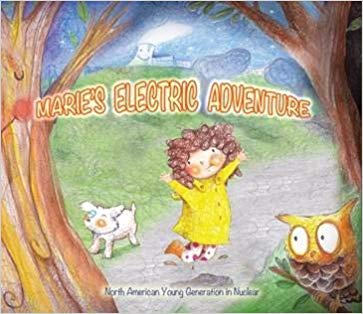It’s time to take back the narrative and rewrite the nuclear story
The facts are clear. Nuclear power is a critical part of our global low carbon electricity generation system. It provides abundant, reliable and economic low carbon electricity needed to power our energy hungry economies. Yet, as stated in the recent IEA report, Nuclear Power in a Clean Energy System, even though the use of nuclear power has reduced carbon dioxide (CO2) emissions by over 60 gigatonnes over the past 50 years, (nearly two years’ worth of global energy-related emissions), nuclear power has begun to fade in advanced economies, with plants closing and little new investment made, just when the world requires more low-carbon electricity.
One issue that puzzles many in the nuclear industry is why we struggle to communicate our many merits to the public, unable to overcome the fear of nuclear that drives much of its opposition. The answer is simple. We talk in facts and figures, but people think in stories with emotion. As stated by Yuval Harari, in his newest book, 21 lessons for the 21st century ( make sure you also add his previous books, Sapiens, and Homo Deus to your to-read list), “Humans think in stories rather than in facts, numbers or equations, and the simpler the story the better.” It is therefore time to ask – what is the nuclear power story?

For an example of a positive story, we only need look as far as the renewables industry, with their compelling story that the world can be powered by nature using energy from the sun and the wind. These energy sources are limitless (after all, we will never use up all the sun and the wind) and have no negative environmental impact because they come from nature. Obviously, we need to increase their use until they meet 100% of our energy needs.
This powerful story resonates with the public well beyond environmental groups to the point where many governments are fully supportive and are putting policies in place to realize this utopian dream. The fact that making this dream a reality is proving much more difficult than its supporters expected (as can clearly be seen in places like Germany and California), doesn’t seem to phase any of the believers. They love their story and they know with absolute certainty that any technical impediments can be solved with time and effort and that wasting time on any other energy source is a foolish diversion from what is really important. This is in spite of the fact that you can’t change the laws of physics or make the sun shine or the wind blow more than they do. But the faithful know they are on the right path and will not be dissuaded from their goal.
Why does this work? As discussed by Harari, facts often get in the way of a good story. A story not anchored in facts requires faith, and faith is a very powerful motivator.
On the other hand, the nuclear story has been dominated by those that oppose the technology. The story, based on extreme fear of radiation, is the technology is so dangerous that when it goes wrong (not if, but when) it may actually destroy all of mankind. Even many who support nuclear power believe the industry is made up of smart capable people who are safely managing doomsday machines. The fact that nuclear is by far the safest form of energy generation gets lost in the story that while the probability is low, the consequences of a big accident are unimaginable. Yet the reality is we have had big accidents and while the impact has been significant, they have proven that people can indeed be protected from harm – the most recent big accident at the Fukushima plant in Japan has resulted in zero deaths from radiation, but nobody believes it – it is inconsistent with this nuclear story.
The companion to this story is that even without accidents we have to fear nuclear waste. It is told that it’s so dangerous that we need to bury it deep underground and protect society from it for thousands of years, the time it takes to decay away. This is a good example of how stories are made. All other toxic waste streams remain toxic forever. Therefore, the fact that nuclear waste eventually decays away should be a positive, or alternatively just assume it is bad forever like every other waste stream. But somehow, the fact that nuclear waste takes a long time to decay has been woven into a story of absolute fear of what we will do to the environment somehow making many believe that this waste is much worse than all other forms of waste. (This does not consider the fact that this waste is in solid form and in very low quantities – because who wants the facts anyway?)
After hearing these negative stories for so long, the industry is constantly on the defensive trying to fight the stories with factual arguments; in effect becoming part of the very stories we are trying to change. Well, the time has come to take back the narrative and re-write the nuclear story.
One position taken recently to try and shake things up is the story that wind and solar just aren’t enough to meet all our energy needs reliably due to their low energy density and intermittency. We explain that storage at the levels required to make up the difference is very unlikely meaning that the 100% renewables goal only serves the fossil industry as gas and coal are needed to back up these unreliable energy sources. We then say that if we want to decarbonize and quickly, we need nuclear as it is the only large-scale low carbon dispatchable generating source. Or as said in this recent article, “even if we don’t love it, nuclear is the only carbon-free generating source that can provide backup power at the scale required.” The article then goes on to tackle all the anti-nuclear stories talking about safety and waste. The problem with this approach is that we are telling a story that is not a happy one – it is the story that while we may all agree we don’t like nuclear; we need it. It is always hard to get people to stand behind things they don’t like by telling them they are good for you. And in our experience, being the option of last resort (we wish we had other options, but we don’t) is never a good strategy. Because as shown in Germany who had 30% of their generation from nuclear and is now phasing it out as they try and decarbonize at the same time; eventually fear becomes fact and as long as there seems to be an alternative, it will be taken (sometimes even when it is not working).
We need to keep the opening part of this story, i.e. that we need to reduce carbon to address climate change, and that wind and solar are simply not up to the task – as this is the path to getting those concerned about climate and energy issues to consider other options. But once we get those opposed to nuclear to reconsider because they see the need, we must then tell them a positive story they can embrace, rather than ask them to reluctantly accept something they don’t like. Some think that this is too late – that people can’t change their thinking. But going back to Harari, he notes that individuals can “knit revolutionary personal changes into a coherent and powerful life story: “I am that person who was once a socialist, but then became a capitalist; I was born in France, and now live in the United States; I was married, and then got divorced; I had cancer, and then got well again.”” So why not I was once against nuclear but now I support it?
Well then – what is our nuclear story? How about an optimistic story about an exciting prosperous future where we all benefit from abundant, reliable, economic energy; raising millions of people out of poverty, all while also protecting the environment? And the best part is that nuclear can actually deliver. Now that is a story I would want to tell my grandchildren. What do you think the nuclear story should be?





3 Comments
Cosmos Voutsinos · August 29, 2019 at 1:05 pm
Excellent points.
James Smith · August 29, 2019 at 1:26 pm
Hello Milton While I agree that the story has to be presented differently, in some cases, we have to look at the story we are trying to present and judge if it is in fact truthful. Here in Canada, there is a concerted effort to try to justify a program to develop small modular reactors. Having been doing this for close to 10 years, I realize now that it is really “a bridge too far” for this country. It’s not that I don’t think it can be done .. reactors work. That genie got out of the bottle 60 or more years ago. The issue is that the costs we are talking about for an SMR in published documents are at least an order of magnitude below the true cost, and development time will be decades, not “a few years”. The real costs and real schedules cannot be justified. Others (China, Russia, Korea, etc.) are already well along with development work. If the world can work together (except Canada, sadly) on fusion development with ITER, why can’t we work together with others on SMRs? (We actually have no choice in this as all SMRs run on enriched fuel, which we can’t produce here in Canada). Sadly, we are trying to launch a uniquely Canadian program when there is absolutely no need or justification to do so. The potential customers such as small communities of Indigenous people absolutely do not want these products in their back yards, the SMR developers are too small to self-finance prototypes, our Governments can’t afford to finance prototypes, and we should call this off before it escalates into another Avro Arrow. The only beneficiaries will be AECL and SNC-Lavalin, getting the benefit of a few engineering dollars before they run out. What we need to do in this country is start looking at long term large scale energy needs, and focus development on achievable products which will really do the job. If you project, for example, Ontario’s energy supply and demand picture over the next 50 years, you conclude that peak demand will be in the 28,000 to 35,000 MWe range, and we are about to start LOSING 14,000 MWe after the CANDUs run out of refurbished life. What then? Will a few prototype 30 MWe SMRs solve that, or should we embark on a program of new, large scale nuclear? In about 1980, Sweden had its famous referendum, concluding that they would shut down all of their nuclear plants by 2010 (50% of their capacity). This, of course, proved unrealistic and most of them are still in operation. The problem is that 30 years after a refurbishment, a CANDU must either face another multi-billion dollar refurbishment or be shut down. 2nd refurbishments are unlikely. Coal or gas burning is unlikely due to environmental damage. Further expansion of hydro-electric is sort of possible, but only on a limited scale. Further expansion of wind and solar, as you point out has its limitations as well. Why not focus on a new fleet of large reactors. If AECL wants to do research, let them work on a 60-year pressure tube. Alternately, let’s look at new supply options such as PWRs on guaranteed BOO contracts which are readily available (China, Korea etc.). SMRs at this point are a boutique product, a complete waste of time and money, and the present program in Canada is, to me just a con job trying to get the Government of Canada signed up to support a development program which will cost billions of dollars with no benefit to the country. Let’s focus on something that will make a big difference. If we are speaking the truth, and we are passionate about it, it will be relatively easy to make a happy story out of it.
Anton van der Merwe · August 30, 2019 at 4:15 pm
How about this story?
All humans on this planet deserve the same opportunity to live long, healthy and happy lives. But there is a problem. In order to be happy and healthy we need a beautiful environment full of the plants, animals and creatures that we love and depend on. How can so many of us live on this planet with room for nature? The key to this is to use our innovative ability to produce what we need with the least impact on our environment. When it come to energy, which is absolutely essential for so many things that make our live healthy and happy, we should surely exploit the form of energy which has the smallest impact on the environment. An energy source that is incredibly rich and abundant and it produces so little waste that we can collect it all and store it safely. We have this technology, we have been using it for 60 years. It has proven itself to be by far the safest way to produce energy with the least harmful impact on the environment. This is nuclear energy. While it is already safe and efficient, we know how to make it even safer and more efficient. It can provide all humans with all their energy needs while doing far less harm than any other energy source.
Comments are closed.